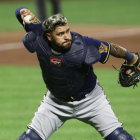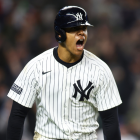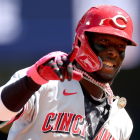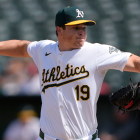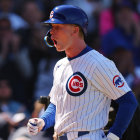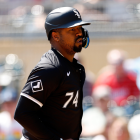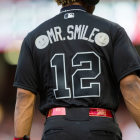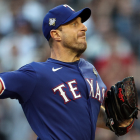
The Milwaukee Brewers have played only six games so far this season, but it's fair to write that they've had an up-and-down year. They've alternated wins and losses; they've had Christian Yelich scuffle, Ryan Braun get hurt and Lorenzo Cain (understandably) opt out; they just had their home-opening series postponed due to another team's COVID-19 outbreak; and now they're about to play 17 games in a row against postseason contenders. Sprinkle in Keston Hiura's and Brandon Woodruff's hot starts, and somehow the Brewers have crammed, oh, at least a month's worth of narratives into six measly games.
Here's another: The Brewers may -- may -- have coached up catcher Omar Narvaez's defense to the point where the trade that netted him over the winter can be classified as a far better deal than it appeared it at the time.
Remember, when the Brewers acquired Narvaez (from the Mariners, for Adam Hill and a draft pick that turned into Connor Phillips) to replace Yasmani Grandal, the thinking was that they would tolerate his poor mitt in order to plug in his bat (career .267/.361/.411). It's early, but Narvaez is looking and grading like a much better receiver than he did during either of his previous stops with the Mariners and the White Sox.
To wit, last season Narvaez ranked 67th (Baseball Prospectus) and 58th (Statcast) in the two major publicly available framing metrics. So far this year, he ranks sixth and first, albeit in a small sample size. (Framing numbers tend to stabilize quickly for reasons we'll touch on.) What has changed? Plenty.
Take a look at few cherrypicked examples, beginning with some missed chances in 2019:
And now 2020:
What, precisely, makes a catcher an effective framer is still up for debate. It's generally accepted that catchers want to create good sightlines for umpires, and that they want to have nuanced movements, and that they want to look in control, even if that mid-90s projectile hurtling toward them is moving in an unpredictable and unexpected way. Some catchers have found that they need to embrace a different stance in order to maximize their framing effectiveness, which is how you get stories about Gary Sanchez moving to the one-leg stance.
Narvaez's adjustments took him the other way. He's set up in a more traditional crouch, but it appears that this tweak has allowed him to have a stronger core. He's no longer drifting with the pitch at the point of contact. His movement after catch still isn't subtle, and he still isn't Jose Molina. The overall effect, however, makes him look more in control -- and that matters, maybe.
Framing matters, too. It's easy to scoff at some of the numbers -- Narvaez cost the Mariners more than eight runs last season -- but the logic that states it's the most important catching skill appears sound. Think about it this way: a catcher sees more framing opportunities than anything else. Narvaez had more than 6,000 framing opportunities last season, versus 71 stolen-base attempts and just under 4,000 blocking chances. If a genie offered a catcher the chance to be good at one of the three areas, the catcher would be wise to pick framing.
The Brewers probably don't have a genie floating around, offering catchers a free skill upgrade. But if Narvaez's gains prove somewhat legit, then they just might have a multi-year fix behind the plate who can hit and frame -- and who came at a bargain-level transaction cost.













